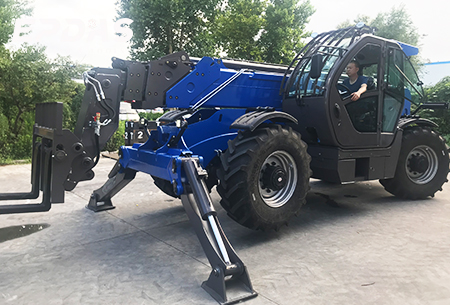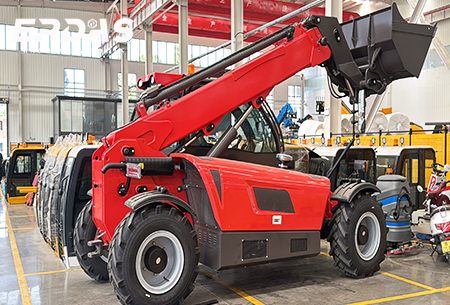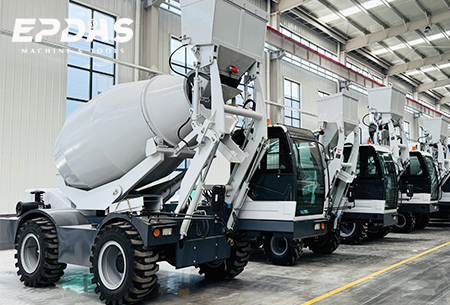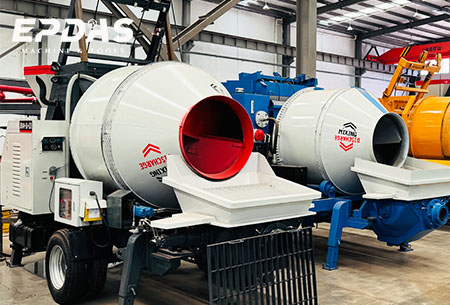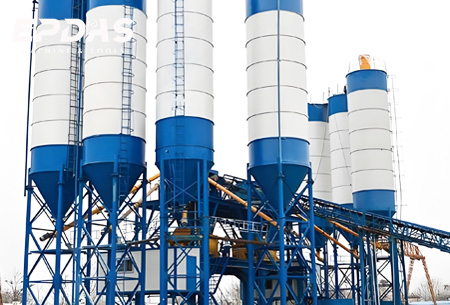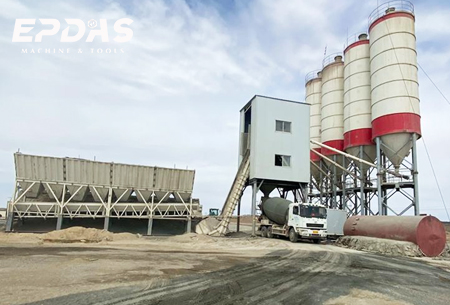In traditional concrete construction processes, mixing and pumping often require two pieces of equipment to work together, which not only takes up a lot of space and is inefficient, but also increases labor and transportation costs. To solve this problem, concrete mixer with pump machines have emerged and become indispensable high-efficiency equipment in the modern construction field.
A concrete mixer with pump is a kind of modernized engineering machinery equipment integrating concrete mixing, pumping, and pouring functions. It realizes the whole process of operation from raw material mixing to accurate pouring through the automation system.
Its core value lies in breaking the traditional operation mode of separating mixing and pumping, integrating mixer, conveying pump, placing pipeline and other equipment into one, which is widely used in house construction, road and bridge, water conservancy project, and other scenes.
Compared with conventional equipment, the cement mixer pump eliminates the need to transfer concrete from the mixer to a separate pump, simplifying the construction process and saving significant time and labor costs. It can mix and remotely pump by integrating a conventional concrete mixer and a concrete transfer pump into a single unit, which is welded to a frame with wheels and axles for easy mobility.
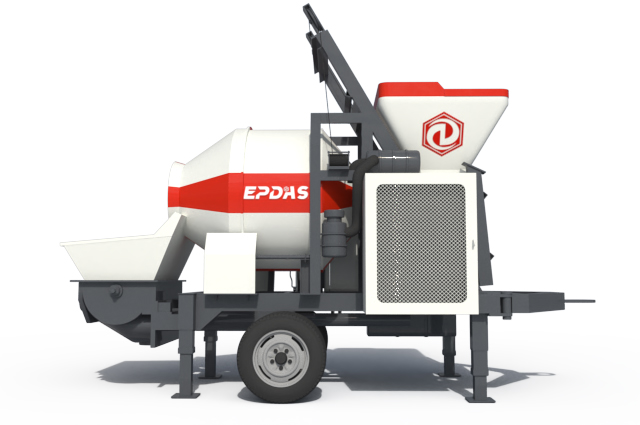
This is the mixing core of the plant and is responsible for mixing the various raw materials into concrete. It usually consists of a mixing drum or container in which cement, sand, aggregate, and water are evenly mixed. Some concrete mixing and transfer pumps are designed with double shafts or double drums to improve mixing efficiency.
This component is responsible for delivering the mixed concrete to a specified location. It usually consists of a series of pipes, valves, and a piston or rotary pump through which the concrete is pushed through the pipes.
The hydraulic system powers the mixer and pumping unit, which provides the force needed to operate the various components of the equipment, including drum rotation, pump movement, and valve control.
The chassis, as the core bearing structure of the concrete mixer pump machine, not only bears the weight of the whole machine and the dynamic load during transportation, but also is the key system to realize the mobility of the equipment. Its composition covers four modules: power system, transmission system, traveling system and steering and braking system:
The power system usually adopts a high-power diesel engine to meet the dual power demand of pumping operation and long-distance transit;
The driving system includes a high-strength steel frame, suspension, and special engineering tires, and some high-end models are equipped with all-wheel drive and oil-pneumatic suspension to ensure stability under complicated road conditions;
The steering and braking system integrates hydraulic power steering and disc brake technology, and the braking distance can be controlled within 10 meters under full load conditions to ensure construction safety.
Diesel powered mixer pump: Suitable for construction sites without stable power supply, powerful and suitable for large-scale projects. In rural areas or places with unstable power supply, diesel engine is the first choice, and its performance is more stable than pump mixer with electric engine.
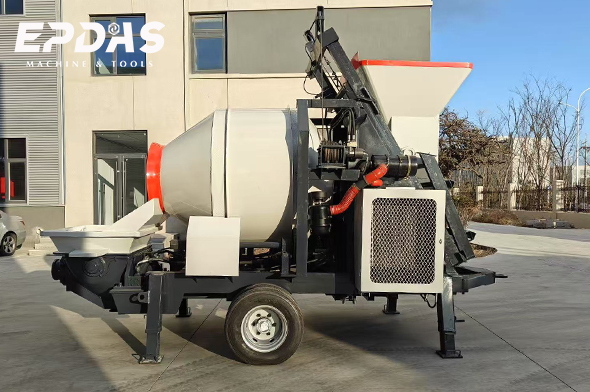
Electric powered mixer pump: Environmentally friendly and energy saving, suitable for urban and indoor construction. Electric concrete pumps provide power and convert energy through electric engines, which are less costly than diesel models, and it still meets the power requirements for mixing and pumping as long as the electricity supply is stable and up to the rated voltage standard.
Another advantage of the electric engine is that it is less noisy and more environmentally friendly, which will not cause complaints in projects near residential areas. In addition, it is lighter than diesel mixing and conveying pumps and does not require a full tank of fuel, which reduces the need for complicated maintenance steps.
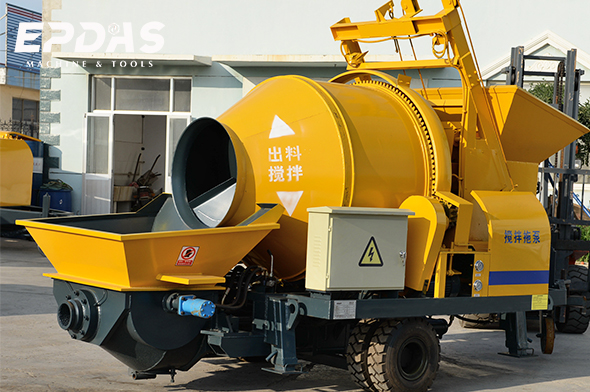
The concrete mixer pumps are available in two standard capacity models: 30m³/h and 40 m³/h. The 30m³/h models are suitable for small and medium-sized projects, such as community renovation, rural road construction, etc., with its relatively compact size and low energy consumption, which can flexibly cope with the construction environment with limited space.
The 40 m³/h models are more suitable for large-scale infrastructures, such as highways, it is more suitable for large infrastructure projects, such as highway, commercial complex construction, this model has stronger continuous operation ability, can deliver more concrete per unit of time, significantly improve the construction efficiency.
Users can scientifically select the appropriate equipment model according to the scale of the project, the requirements of the construction period and the conditions of the construction site.
Aggregate loading: The required aggregates (e.g., sand, gravel, and cement) are first loaded into the hopper or drum of the concrete mixer in a pre-determined ratio based on the mix ratio of the required concrete.
Addition of water: After placing the aggregate and cement in the drum, an appropriate amount of water is added to initiate the hydration process, and to achieve the desired consistency, the amount of water needs to be carefully controlled to ensure the strength of the concrete mixture.
Mixing: Once all the components are in place, the mixer drum starts to rotate, promoting the thorough mixing of the aggregates, cement, and water by means of a rotating motion. The continuous mixing in the drum ensures that each particle is evenly distributed in the mixture to obtain a homogeneous concrete.
Preparation: Ensure that the pumping system has been started up correctly, open the necessary valves, ensure that the delivery line is free of any obstructions, and check the pumping controls and pressure gauges to ensure that they are working properly.
Start Pumping: Activate the pumping system by turning on the power and activating the pumping controls, adjusting the throttle or speed control to set the desired pumping speed, and monitoring the pressure gauges to ensure that the system maintains the proper pumping pressure.
Concrete loading: Load the well-mixed concrete from the mixing drum into the hopper of the concrete mixing and transfer pump, ensuring a constant and steady supply of concrete to the hopper to avoid interruptions in the pumping process, using conveyor belts, hoppers, or other equipment to do so if necessary.
Concrete conveying: After starting the pumping, the concrete is pushed out from the mixer through the pumping system, the hydraulic cylinder or piston generates the necessary force to push the concrete forward, the concrete passes through an S-valve mechanism, which consists of two valve flaps that open and close alternately.
The S-valve system ensures a unidirectional flow of the concrete and prevents backflow, the conveyor line is positioned manually or with the help of an extension mechanism in order to arrive at the desired position, ensuring that the conveyor The line is properly supported and stabilized to prevent excessive movement or sagging.
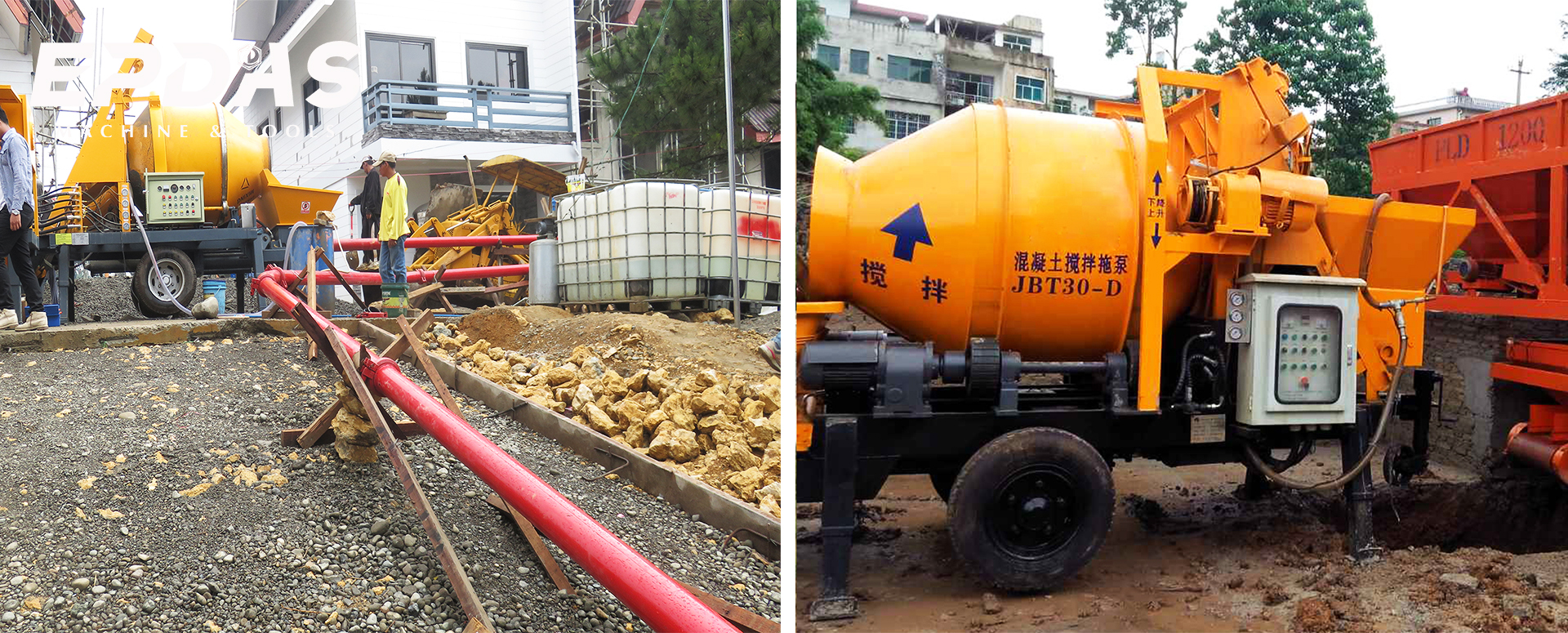
Integrated Design:The mixing and pumping modules work together seamlessly, eliminating the time wasted in traditional processes due to concrete transfer and reloading (saving more than 30% of process time).
Power system optimization: Using a high-pressure hydraulic system and smart electronic control technology, the mixing speed and pumping pressure are dynamically matched, reducing energy consumption by 15% to 20%.
On-site Mixing: Directly mix raw materials such as aggregates and cement at the construction site, eliminating the need for pre-mixed concrete transportation (Avoid traffic delays and slump loss within 2 to 4 hours).
Continuous working Capability: A concrete mixing pump machine completes the entire process from “material feeding → mixing → pumping → pouring,” reducing equipment scheduling and coordination waiting times.
| Process | Traditional Process | Concrete Mixer Pump Machine | Efficiency Improvement Rate |
| Concrete Preparation | Concrete batching Plant 2h + Transportation 1.5h | On-site Mixing 0.5h | ↑ 300% |
| Pumping Distance | Fixed pump maximum horizontal 500m | Mobile pump horizontal 800m+vertical 120m | ↑ 60% |
| Daily Pouring Volume | 200-300m³ (multiple machines collaborating | Single machine 450-600m³ | ↑ 100% |
| Labor requirements | 8-10 people for mixing and pumping | Only 4-5 people for operation and assistance | ↓ 50% |
Efficient Scenario Application Verification
High-rise building core
– Challenge: Vertical pumping height of 120m+ and narrow space with pouring accuracy requirements of ±3cm.
– Solution: The integrated machine is equipped with a 32MPa high-pressure pump pipe + S-shaped distribution valve, achieving pulse-type precise material distribution, completing 32 floors of the core in a single day (saving 5 days of construction time).
Road Construction in Hilly Areas
– Challenge: Continuous pouring in areas with a 25° slope and dense curves.
– Solution: Utilizing a fully hydraulic flexible boom(360° rotation) with automatic pressure compensation, pumping C30 concrete without segregation, achieving an efficiency of 45m³/h (200% faster than segmented pouring).
Efficiency Marginal Gain Technology
Intelligent Diagnostic System: Real-time monitoring of oil temperature, hydraulic sealing integrity, and wear part lifespan, with fault warnings to reduce downtime (MTTR reduced to under 40 minutes).
Aggregate Adaptive Algorithm: Automatically adjusts mixing torque and pumping pressure based on aggregate particle size (5–31.5 mm), reducing blockage rate to <0.5 times per thousand cubic meters.
Modular Quick-Change Design: Wear part replacement time (<2 hours for S-tubes and wear plates) improves maintenance efficiency by 50% compared to traditional equipment.
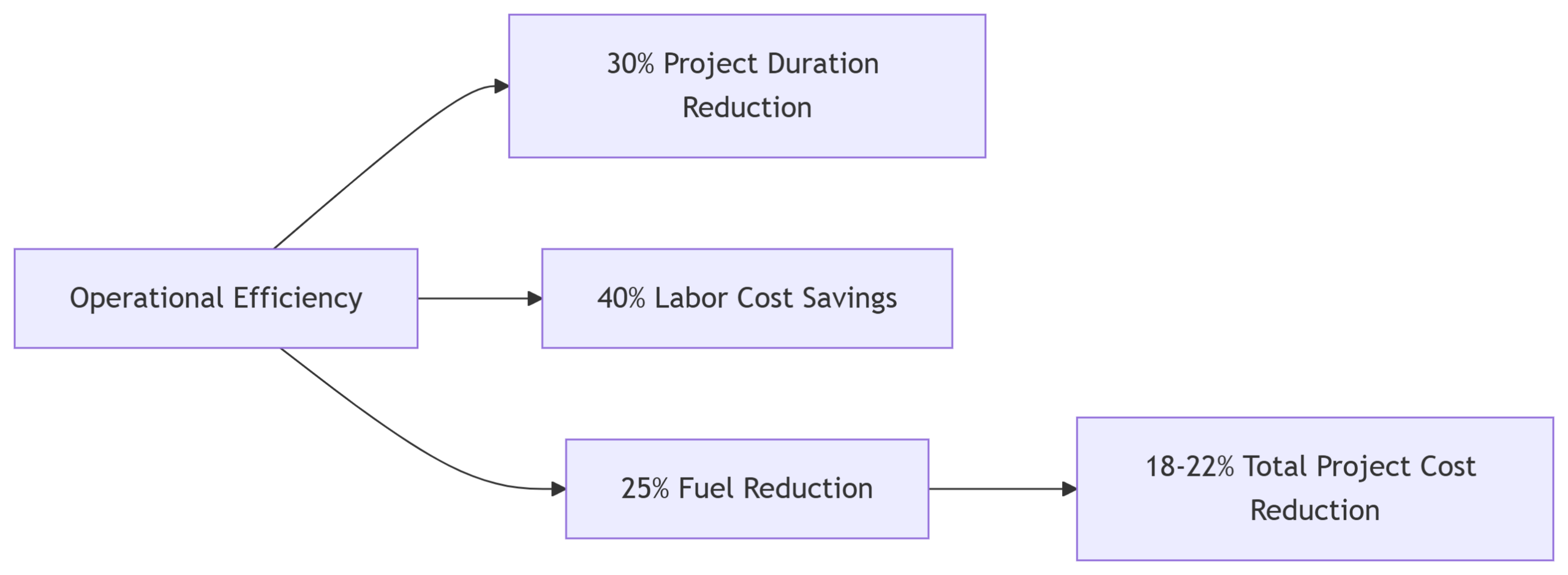
The concrete mixer pump machine achieves operational efficiency through three innovations: functional integration, intelligent control, and precise operation and maintenance, translating operational efficiency into project effectiveness. Its efficiency advantages are particularly evident in complex conditions such as super-high-rise buildings, tunnels, and remote infrastructure projects, making it a core piece of equipment for modern intensive construction.
Our hydraulic tanks utilize specially treated steel tubing to prevent corrosion and extend system life. For tank cleaning, hoses and valve blocks are thoroughly cleaned to eliminate contaminants, ensuring clean circulation of hydraulic fluid and minimizing wear.
Diesel clean ports are heat-treated and purged with compressed air to remove all impurities, ensuring cleaner oil. By keeping the hydraulic fluid pure, we minimize system failures and extend operating life.
Prior to shipment, we utilize high, medium and low pressure tests to ensure that the machine works consistently and operates without leaks, and we verify performance under actual working conditions, so you receive a fully optimized mixing and pumping machine.
Our mobile concrete mixer transfer pumps include voltage and current stabilization features that prevent power fluctuations and ensure uninterrupted operation. They monitor power conditions in real time and can instantly adjust abnormal readings to ensure continuous and stable operation of equipment. This stability ensures that projects are completed on time, reduces long-term maintenance costs by up to 30%, and guarantees that concrete quality meets the highest standards.
Concrete mixer transfer pumps feature 125 mm diameter, 4.5 mm thick (5 mm at elbows) piping that ensures superior strength and abrasion resistance. In addition, we have C-type quick clamps for fast, tool-free installation and removal, dramatically saving you time and increasing productivity on the productivity.
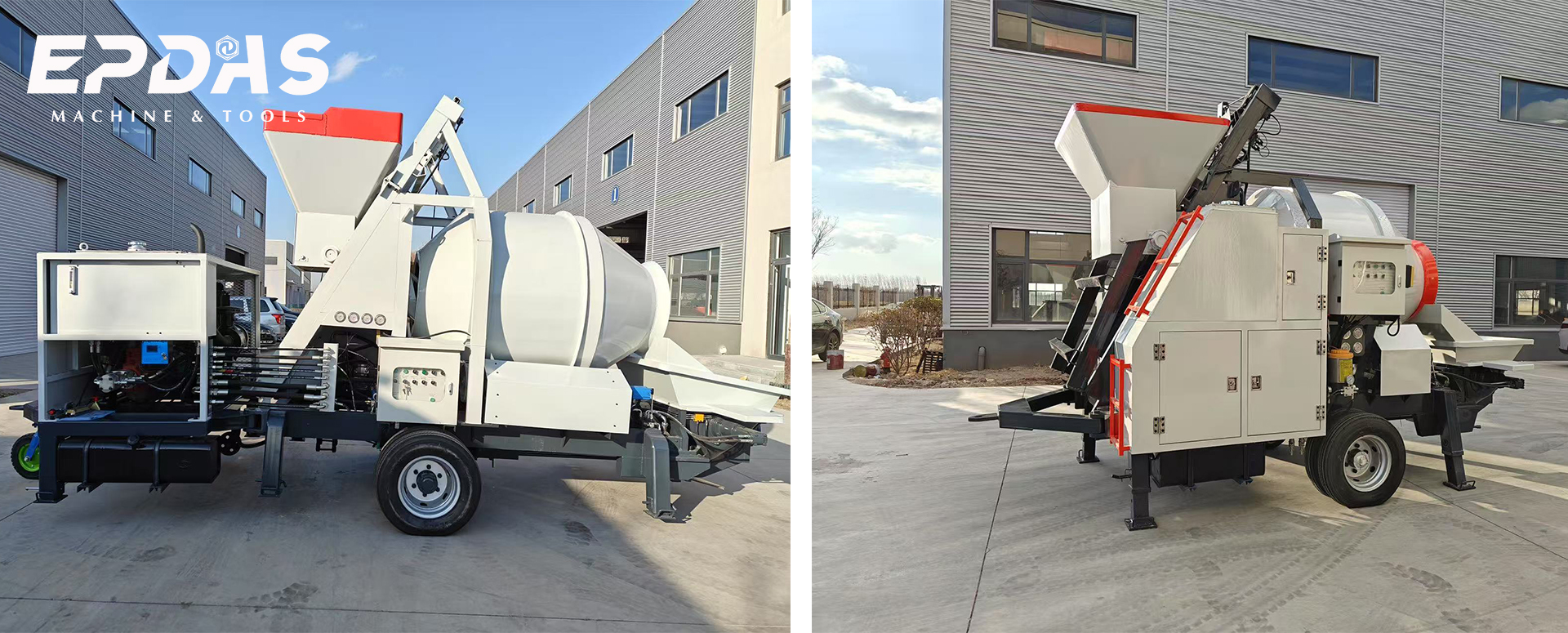
High Efficiency and Energy Saving
The concrete mixing and conveying pump is equipped with high-speed forced double-shaft mixing system, which can form staggered convection mixing mode through two sets of spiral blades, and can complete uniform mixing of a single batch of concrete in 3-5 minutes, which improves the efficiency of traditional mixing equipment by more than 40%.
The high-pressure pumping technology adopts a frequency conversion hydraulic drive system, with a maximum vertical conveying height of 300 meters and a horizontal conveying distance of 1,500 meters. Meanwhile, through the intelligent power adjustment module, it can automatically match the energy consumption according to the conveying pressure, which saves about 25% of energy compared with the same type of equipment.
Environmentally Friendly
Equipped with low-noise hydraulic system and closed mixing structure, the noise level during operation is controlled below 75dB, which meets the environmental standards of urban construction.
In terms of exhaust emission, it adopts National IV/Euro V emission standard engine, and is equipped with particle trap and exhaust purification device, which can effectively reduce the emission of PM2.5 and nitrogen oxides. The anti-drip design of the mixing drum and the residual concrete recycling system can prevent the construction waste from polluting the soil and water.
Strong Adaptability
The concrete mixer pump has an all-terrain chassis and flexible steering system, which can adapt to complex terrain with a slope of ≤25°. For high-rise building construction, it can realize ultra-high-rise concrete conveying through modular pipeline splicing; in narrow corridors or tunnels, its minimum working width is only 3.2 meters, and with the folding boom, it can complete precise pouring in narrow spaces.
In water conservancy projects, the equipment can switch the pumping mode according to the working conditions to meet the demand for large aggregate concrete pouring.
Easy Operation
The equipment is equipped with PLC intelligent control system, through the 7-inch touch screen display can be a key to switch the mixing, pumping, cleaning and other work modes. The operation interface supports multi-language display, and new operators can work independently after 2 hours of training.
The system has a built-in fault diagnosis module, which can monitor more than 20 parameters in real time, such as hydraulic oil temperature, pumping pressure, etc., and automatically alarm and generate maintenance guidelines in case of abnormality, which greatly reduces the difficulty of manual maintenance.
High Precision
Adopting servo motor-driven metering system, the accuracy of concrete flow control can reach ±1%, and with laser positioning device, millimeter-level pouring error control can be realized.
In the construction of complex curved structures, through the 3D modeling import function, the equipment can automatically plan the pouring path to ensure that the concrete filling compactness reaches more than 99%, which effectively reduces rework waste and improves the acceptance rate of project quality.
Superior Mobile Performance
The equipment adopts vehicle-mounted chassis design, the maximum driving speed can reach 80km/h, through the national highway transportation standards. The whole machine can be quickly transferred by flatbed trailer, and it takes only 4 hours from disassembly to reassembly and commissioning.
For small projects, the optional electric wheeled chassis can be used to support short-distance driving into the construction site, which significantly shortens the equipment transfer time and improves the turnover efficiency of the project.
Output capacity: This is the core index to measure the working efficiency of concrete mixing and conveying pump, which directly determines the amount of concrete that can be conveyed per hour. Take the common DJBT60 mixer pump as an example, its theoretical maximum output is 60 cubic meters/hour, but in actual construction, affected by the concrete proportion, pumping distance, pipeline bending degree and other factors, the actual output is usually in 40-50 cubic meters/hour.
When choosing, it is necessary to reasonably match the output capacity according to the scale of the project and the requirements of the construction period, so as to avoid delays in the construction period due to insufficient capacity or wasteful idling of the equipment due to over-configuration.
Power source: concrete mixing and conveying pumps mainly use diesel power and electric drive. Diesel power has strong mobility and independence, without external power supply, suitable for insufficient power supply or remote sites, but its running costs are high, and the noise and exhaust emissions generated by the diesel engine need to comply with environmental standards.
electric power have the advantage of low energy consumption, low noise, low maintenance costs, suitable for construction in the city or projects with stringent environmental protection requirements, but rely on a stable external power supply, you need to confirm the site transformer capacity and power supply line layout in advance. However, it relies on stable external power supply, so it is necessary to confirm the transformer capacity and power supply line layout of the construction site in advance.
Maximum horizontal and vertical pumping distance: This parameter is directly related to whether the concrete can be accurately delivered to the construction site. For example, ultra-high-rise projects need to pay attention to the vertical pumping capacity, some high-end equipment can achieve more than 500 meters of vertical height conveying; large-scale road and bridge projects require a higher horizontal pumping distance, and some models of horizontal conveying up to 1500 meters.
In practical application, it is necessary to calculate the effective conveying distance according to the building structure and pipeline arrangement. Considering the pipeline resistance, the number of elbows and other losses, it is recommended to reserve 20%-30% of the parameter redundancy, so as to ensure the continuity and completeness of concrete pouring.
Maximum aggregate diameter: This parameter determines the maximum particle size of pumpable aggregate, which directly affects the risk of pipe blockage. Generally speaking, the ratio of the maximum aggregate diameter of ordinary concrete pumps to the diameter of the conveying pipe needs to meet 1:3-1:5 (such as the pipe diameter of 125mm, the maximum aggregate particle size should not exceed 40mm).
Before construction, the particle size distribution of gravel aggregate should be determined accurately, so as to avoid pipe blockage due to the entry of oversized gravel or lumpy materials into the pipe.
At the same time, for special grade concrete (such as fine stone concrete), it is necessary to choose the appropriate pump type or replace the special pipeline to ensure the stable operation of the pumping system.

Type of construction project: determine if your project involves houses, buildings, roads, highways, bridges, tunnels, culverts, etc.
Pumping Distance: Determine how far the concrete needs to be pumped horizontally and vertically to ensure that the mixer transfer pump will be able to meet these needs.
Project Timeline: Know when the concrete mixer transfer pump will be in service and how long the construction project is expected to last to ensure that the pump’s availability and efficiency aligns with the project timeline.
Site conditions and infrastructure: This condition is critical to the choice between diesel-engine concrete mixer pumps and electric concrete mixer pumps.
Evaluate construction site conditions, including the adequacy of power supply and local voltage, to determine the most appropriate type of pump and ensure uninterrupted operation.
♦ The operator needs to follow the equipment manual strictly.
♦ Use safety devices such as directional signs, fences, etc. to prevent accidents.
♦ Do not use the hopper if the grill is damaged.
♦ Regularly inspecting equipment components to ensure that they are in good working order can extend the life of the equipment by up to 30%.
♦ Reduce maintenance costs by 25% with genuine hydraulic fluid.
♦ Specialized operator training to reduce the failure rate by 60%.
♦ Clean the unit thoroughly after each use to avoid concrete residue.
♦ Construction sites need to have secure areas to avoid access by uninvolved people.
♦ Operators are required to wear protective equipment such as helmets.
♦ Pipe clogging: Reverse pump 2-3 times immediately after positive pumping.
♦ Hydraulic oil temperature is too high: stop pumping and check the cooling system.
♦ Boom wobble: Test counterbalance valve/hydraulic lock status.
Concrete mixer pumps simplify the building construction process by integrating mixing and pumping functions into a single mobile solution. Their efficiency, cost savings and adaptability make them a must-have for modern projects – from rural developments to urban skyscrapers.
By prioritizing proper specification, maintenance and safety, contractors can maximize return on investment and deliver projects faster than ever before. If you’re ready to transform your construction workflow, explore our DJBT and EHBT range of models for tailored solutions. Contact us for the latest solutions!
